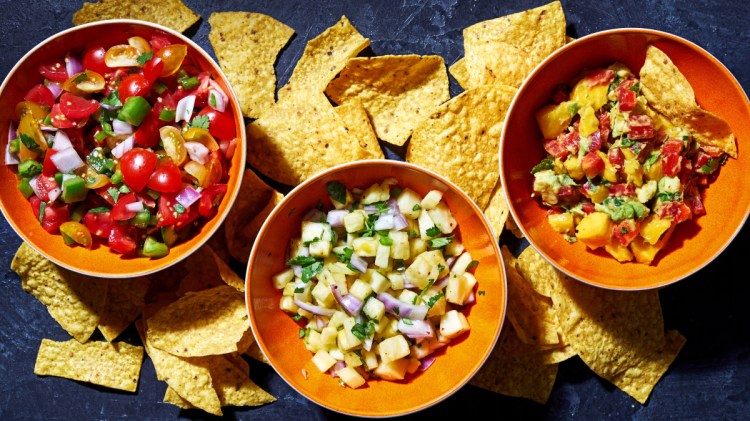Standing in the salsa aisle at the grocery store can make your head hurt. Classic tomato? Or go rogue with corn or peach? Big jar? Small jar? Mild, medium or hot? How hot is hot?
Of course, you can’t beat the convenience of grabbing whatever jar is closest to you. But homemade salsa can be a great way to make a satisfying dip that is exactly to your liking. You can put together a ton for a party to serve with tortilla chips or a little to top your fish or chicken dinner. Coming up with your own can also help you burn through extra produce you might have hanging around.

Outside of peak tomato season, opt for cherry or grape tomatoes. Here they’re combined with red onion, jalapeño, green pepper, cilantro and lime.
For simplicity’s sake, as well as spur-of-the-moment creativity, I’m focusing on uncooked salsas (you might find tomato-based versions referred to as pico de gallo). Here are some tips to get you started.
• “You don’t have to stick to a recipe.” So advises Anna Bran-Leis, owner of the DC Empanadas stand and food truck, and the restaurant Taqueria del Barrio. “You can make salsa out of pretty much anything,” she says. “There’s no real rule to it.” Just follow your personal preferences, although you’ll want to take into consideration some of her other advice.
• Be sure your main ingredient is good. Lackluster tomatoes are a grocery store scourge, especially out of season. In winter or other lean tomato times, Bran-Leis suggests using grape or cherry tomatoes, which tend to be more reliable. Fruit salsa can be great, too. Unless you’re trying for tart and crunchy, see that whatever you’re using – pineapple, mango, peaches – is ripe. Ditto the avocados. If, however, your fruit is not ripe, try grilling it, which will caramelize it and help bring out the natural sweetness.
• Think about texture. Bran-Leis prefers to have ingredients chopped the same size. That way each bite is consistent. There’s at least one exception – especially when it comes to spicier varieties, hot peppers can be more finely minced. Also take into account the mix of ingredients. “You want to think about how it’s going to feel in your mouth,” Bran-Leis says. So don’t make everything mushy. Bran-Leis likes to add jicama for a crisp option. Bell peppers are another go-to.

Pineapple, shown with red onion, jalapeño, cilantro and lime, can provide sweet and tart flavors to a salsa.
• Balance your flavors. Bran-Leis says this might be the hardest part of making salsa. Her ideal: “I want a salsa to be a little bit sweet, a little bit spicy and a little bit tangy.” Sweet can come from fruit, of course. Or even ripe tomatoes, especially the smaller orange or yellow varieties. You may be tempted to reach for the honey if you need more sweetness, but that can get goopy. Agave syrup is a safer bet, Bran-Leis says. Spicy: Fresh chili peppers are a no-brainer. Bran-Leis is a fan of serrano, whose heat is between a jalapeño and habanero. You can use dried peppers, such as ancho, which can impart a smoky flavor, too. Rehydrate and chop, or use as a puree or paste. For tangy and tart, turn to citrus juice. Lemon and lime are obvious choices. Just don’t forget about orange or grapefruit, which can impart sweetness as well. A splash of vinegar is another possibility.
• Don’t forget about your spice cabinet. Spices can be used to cover a variety of flavors. Bring some heat and smoky flavors with chili powder, cumin or ground chipotle powder. Red pepper flakes or Aleppo pepper share their color and kick. Other spices to consider: garlic powder, turmeric (for color and earthy flavor), ginger and garam masala, a favorite of Bran-Leis’s.
• Taste as you go. Try your salsa after most additions, Bran-Leis says. Put in an ingredient, give it a stir and taste. Repeat. It’s the best way to make sure your flavors are indeed balanced.
• Be patient. Wait at least 30 minutes for the flavors to meld, Bran-Leis says. She believes homemade salsa tastes even better the next day, and it can hold for several more days in the refrigerator.
Send questions/comments to the editors.



Comments are no longer available on this story